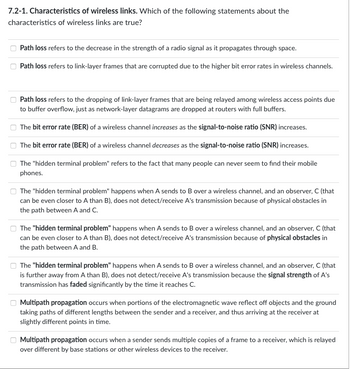
Computer Networking: A Top-Down Approach (7th Edition)
7th Edition
ISBN: 9780133594140
Author: James Kurose, Keith Ross
Publisher: PEARSON
expand_more
expand_more
format_list_bulleted
Question

Transcribed Image Text:7.2-1. Characteristics of wireless links. Which of the following statements about the
characteristics of wireless links are true?
0
Path loss refers to the decrease in the strength of a radio signal as it propagates through space.
Path loss refers to link-layer frames that are corrupted due to the higher bit error rates in wireless channels.
Path loss refers to the dropping of link-layer frames that are being relayed among wireless access points due
to buffer overflow, just as network-layer datagrams are dropped at routers with full buffers.
The bit error rate (BER) of a wireless channel increases as the signal-to-noise ratio (SNR) increases.
The bit error rate (BER) of a wireless channel decreases as the signal-to-noise ratio (SNR) increases.
The "hidden terminal problem" refers to the fact that many people can never seem to find their mobile
phones.
The "hidden terminal problem" happens when A sends to B over a wireless channel, and an observer, C (that
can be even closer to A than B), does not detect/receive A's transmission because of physical obstacles in
the path between A and C.
The "hidden terminal problem" happens when A sends to B over a wireless channel, and an observer, C (that
can be even closer to A than B), does not detect/receive A's transmission because of physical obstacles in
the path between A and B.
The "hidden terminal problem" happens when A sends to B over a wireless channel, and an observer, C (that
is further away from A than B), does not detect/receive A's transmission because the signal strength of A's
transmission has faded significantly by the time it reaches C.
Multipath propagation occurs when portions of the electromagnetic wave reflect off objects and the ground
taking paths of different lengths between the sender and a receiver, and thus arriving at the receiver at
slightly different points in time.
Multipath propagation occurs when a sender sends multiple copies of a frame to a receiver, which is relayed
over different by base stations or other wireless devices to the receiver.
Expert Solution
This question has been solved!
Explore an expertly crafted, step-by-step solution for a thorough understanding of key concepts.
This is a popular solution
Trending nowThis is a popular solution!
Step by stepSolved in 3 steps

Knowledge Booster
Similar questions
- Need 9,10arrow_forwardSolve it , only if you are really very very good in operating system. Otherwise i will downvote. Computer sciencearrow_forwarda) Describe how packet loss can occur at input ports.b) Describe how packet loss at input ports can be eliminated (without using infinite buffers).arrow_forward
- Please provide the justification on the answers. why you decide to use the formula you applying to part b.arrow_forwardالسؤال 2 Consider sending a 3500 byte datagram into a link that has an MTU of 1400 bytes. Suppose the original datagram is stamped with the identification number 333.a) How many fragments are generated? b) What are the values of the various fields, related to fragmentation, in each generated IP fragment?arrow_forward
arrow_back_ios
arrow_forward_ios
Recommended textbooks for you
 Computer Networking: A Top-Down Approach (7th Edi...Computer EngineeringISBN:9780133594140Author:James Kurose, Keith RossPublisher:PEARSON
Computer Networking: A Top-Down Approach (7th Edi...Computer EngineeringISBN:9780133594140Author:James Kurose, Keith RossPublisher:PEARSON Computer Organization and Design MIPS Edition, Fi...Computer EngineeringISBN:9780124077263Author:David A. Patterson, John L. HennessyPublisher:Elsevier Science
Computer Organization and Design MIPS Edition, Fi...Computer EngineeringISBN:9780124077263Author:David A. Patterson, John L. HennessyPublisher:Elsevier Science Network+ Guide to Networks (MindTap Course List)Computer EngineeringISBN:9781337569330Author:Jill West, Tamara Dean, Jean AndrewsPublisher:Cengage Learning
Network+ Guide to Networks (MindTap Course List)Computer EngineeringISBN:9781337569330Author:Jill West, Tamara Dean, Jean AndrewsPublisher:Cengage Learning Concepts of Database ManagementComputer EngineeringISBN:9781337093422Author:Joy L. Starks, Philip J. Pratt, Mary Z. LastPublisher:Cengage Learning
Concepts of Database ManagementComputer EngineeringISBN:9781337093422Author:Joy L. Starks, Philip J. Pratt, Mary Z. LastPublisher:Cengage Learning Prelude to ProgrammingComputer EngineeringISBN:9780133750423Author:VENIT, StewartPublisher:Pearson Education
Prelude to ProgrammingComputer EngineeringISBN:9780133750423Author:VENIT, StewartPublisher:Pearson Education Sc Business Data Communications and Networking, T...Computer EngineeringISBN:9781119368830Author:FITZGERALDPublisher:WILEY
Sc Business Data Communications and Networking, T...Computer EngineeringISBN:9781119368830Author:FITZGERALDPublisher:WILEY

Computer Networking: A Top-Down Approach (7th Edi...
Computer Engineering
ISBN:9780133594140
Author:James Kurose, Keith Ross
Publisher:PEARSON

Computer Organization and Design MIPS Edition, Fi...
Computer Engineering
ISBN:9780124077263
Author:David A. Patterson, John L. Hennessy
Publisher:Elsevier Science

Network+ Guide to Networks (MindTap Course List)
Computer Engineering
ISBN:9781337569330
Author:Jill West, Tamara Dean, Jean Andrews
Publisher:Cengage Learning

Concepts of Database Management
Computer Engineering
ISBN:9781337093422
Author:Joy L. Starks, Philip J. Pratt, Mary Z. Last
Publisher:Cengage Learning

Prelude to Programming
Computer Engineering
ISBN:9780133750423
Author:VENIT, Stewart
Publisher:Pearson Education

Sc Business Data Communications and Networking, T...
Computer Engineering
ISBN:9781119368830
Author:FITZGERALD
Publisher:WILEY